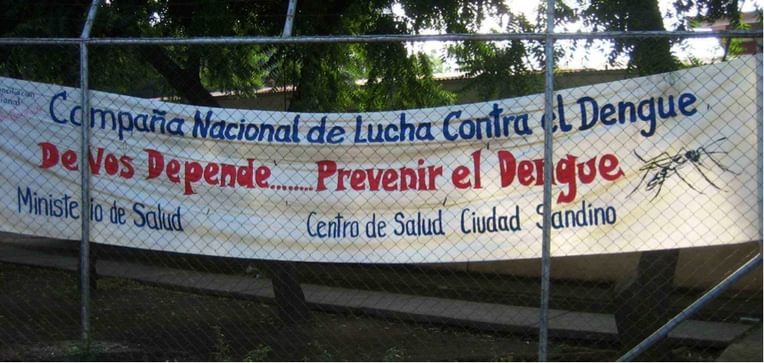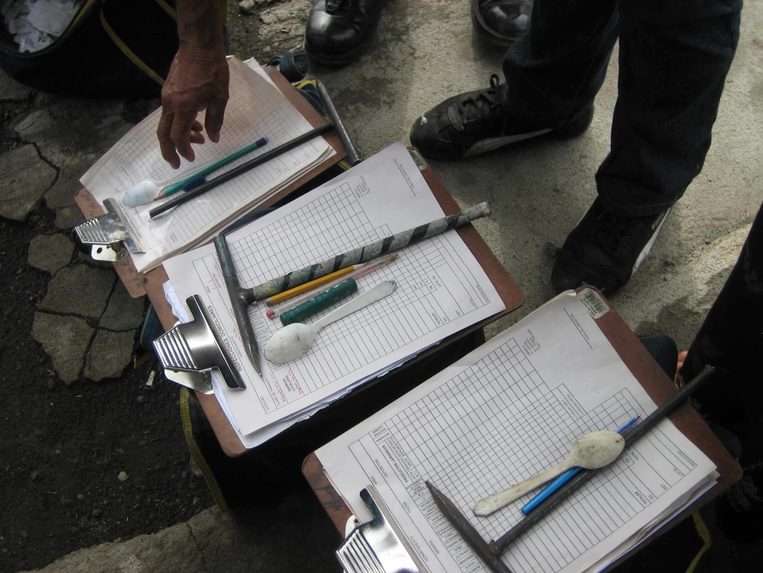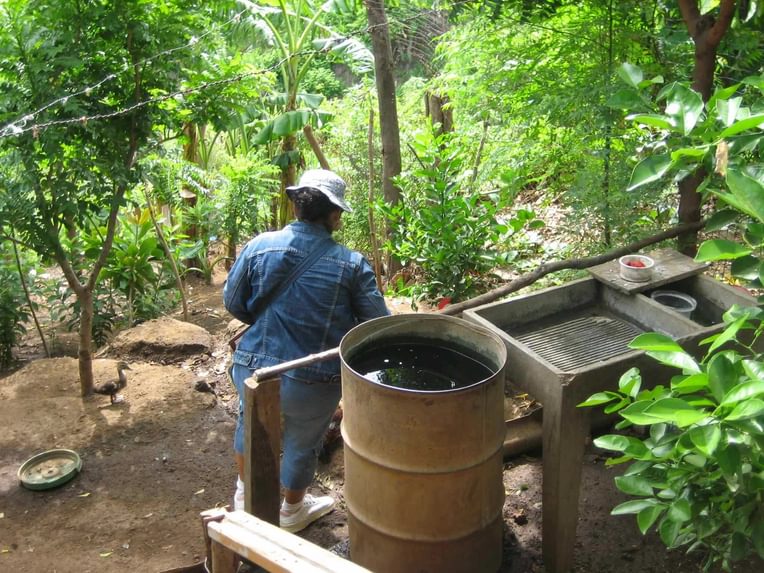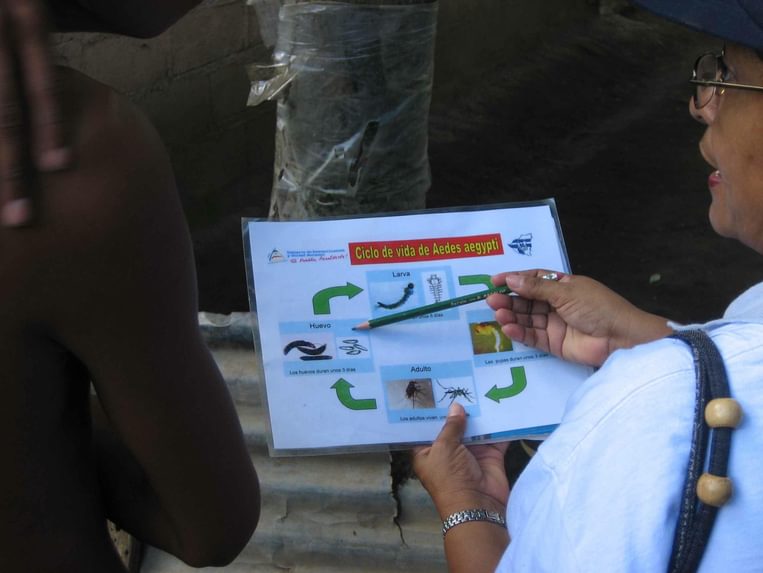This post builds on the research article “Dengue Mosquitos Are Single Mothers: Biopolitics Meets Ecological Aesthetics in Nicaraguan Community Health Work,” which was published in the November 2012 issue of the Society’s peer-reviewed journal, Cultural Anthropology.

Editorial Footnotes
Cultural Anthropology has published a number of articles on human-animal relations and multi-species ethnography including Eva Hayward's, "Fingeryeyes: Impressions of Cup Corals", Celia Lowe's, "Viral Clouds: Becoming H5N1 in Indonesia", and Heather Praxon's, "Post-Pasteurian Cultures: The Microbiopolitics of Raw-Milk Cheese in the United States".
See also the CA November 2010 Special Issue: Multispecies Ethnography
And the new CA Virtual Issue: Ethnographies of Science

Interview with Alex Nading
Stefanie Graeter: How did you find yourself working with the Dengue Brigadistas in Nicarauga? Did you know before beginning fieldwork that you wanted to study a Dengue public health campaign from this perspective?
Alex Nading: Working with brigadistas was always part of my research plan, although what I did not anticipate, because I had not spent much time with them during the pilot phase of my research, was the gendered dimension of brigadista work. I became interested in dengue prevention because it seemed to involve an embodied process of learning and working in a landscape. Somehow, the idea that these embodied practices would have a strong gendered component escaped me as I planned! Even without that crucial piece, dengue epidemics seemed to offer an opportunity to look at the city from a perspective normally reserved in anthropology for the study of more familiar "natural" areas such as forests, hunting, and swiddens; and to study health and ecology from a critical perspective. (The pollution of Nicaragua's lakes and its remediation was actually my original idea for a dissertation project.) Dengue is most certainly a matter of environmental health--and some degree of "environmental degradation"--- but many of the principal players, including the mosquitoes and their habitats, are also alive and in motion through the world. That intrigued me. The brigadista is a familiar figure in Nicaragua and elsewhere in Latin America. I'm finding out now as I discuss this project with my colleagues in medical anthropology that the figure of the community health worker appears in all sorts of contexts, from Vietnam to Malawi to Nicaragua. I am still thinking through how best to characterize this figure cross-culturally. The CHW's prominence speaks in some sense to a lack of other kinds of healthcare providers, but that does not mean that she is simply a less-qualified stand-in for "real" doctors and nurses. It's clear from the evidence I've seen that CHW's are not just auxiliaries. It's more useful to think about the community health worker as an emergent figure--a figure whose identity springs from the uneasy melding of two (or more) other identities (state employee, community advocate, concerned neighbor, patient, midwife, 'traditional' healer, etc) and becomes something new. The brigadistas of today's Nicaragua, I would argue, are quite different from those of the country's revolutionary period, or even the 1990s. Partly, this is because of the ways that international health policy and the state have engaged them, but it's also a function of the epidemiological situation. The first public health brigades in Nicaragua were concerned with nutrition, water, and vaccination, not dengue. Now that dengue is the primary concern, the character of the work has changed. I address some of the related political and economic changes in Nicaragua in the CA article. But I'm still struggling with the fact that community health workers are everywhere, yet nobody seems to agree on precisely what they are or should be.

SG: Where is the place of the Dengue virus itself in your essay? Although your writing takes us through various material and semiotic layers of human and non-human ‘entanglements’, the virus, which is at the center of this public health campaign, seems to dangle just out of our reach. Is this relative absence a reflection of your fieldwork experiences and the public health discourse you came across, or a more theoretical decision you made during your analysis?
AN: I'd push back against that a bit, only to say that the virus is not really at the center of the campaigns. There is no drug or vaccine for dengue, so public health approaches to epidemics remain very much mosquito-centered and therefore very environmental. Even though brigadistas and other householders in Nicaragua were not primarily concerned with viruses, my research assistants and I did a household survey in Ciudad Sandino and found that a surprising number of people were aware that the pathogen was a virus. Still, the health ministry's prevention policy was vector-focused, and if people knew dengue was a microbe, they almost always also knew that it was transmitted. So while viruses were certainly implicated in all that I describe in this article, they weren't foremost on the minds of brigadistas or their neighbors.It's also important to disaggregate dengue the virus (actually, four closely related flaviviruses) from dengue the disease. Dengue fever, strictly speaking, is the result of entanglement among four viruses, mosquitoes--mainly Ae. aegypti, though others are capable of transmission--human immune systems, and habitat. So you're right that there's a whole other story there. As of now, it concerns scientists more than brigadistas, but that may change as vaccine development reaches large-scale trials or implementation phases. I like the phrase "dangle just out of reach," since it really does describe public health's troubled relationship with dengue viruses. These days, research dollars and pharmaceutical capital are turning toward understanding human immune response to the virus, the interaction of the four serotypes with one another, through the human immune system, and--most visibly--the development of dengue vaccines. But it's a tricky process, since the four serotypes all behave differently, most people who get infected never develop full-blown dengue fever, and the viruses and mosquitoes and people are circulating in complex ways across the globe. In my new project, which is on the engineering of these new vaccines and other genomic tools for use against dengue, the virus is more central. Scientists are creating synthetic dengue viruses, or "chimeras," from bits and pieces of all four serotypes and then trying to attenuate them into vaccines, which they then put into clinical trials. The challenge is to find a vaccine that works, and then (hopefully) figure out WHY it works--and then, of course, to convince governments to purchase it. At this point, they're still trying to find something that works. Given dengue's spread, the market for that elusive vaccine is by some estimates in the billions of dollars.
SG: Your piece is often oriented toward demonstrating the pleasure of praxis among the brigadistas, as they inspected for mosquito breeding grounds from house-to-house. Is it important for the greater public health community to recognize the role of ‘play’ and ‘caring’ in their work, like you observed in your fieldwork?
AN: In a word, yes! I know that lots of people who work on the public health side of dengue prevention feel the same way. In different ways, applied anthropologists and their allies talk about enstilling not just a discipline for mosquito control, but a desire to participate. The problem, as Gregory Bateson pointed out a long time ago, is that you can't demand that someone (child or otherwise) go out and play. You might, however, be able to create the conditions under which play can take place. One of the more hopeful examples of this is a project run by an NGO called CIET International and initiated in collaboration with UC Berkeley's Harris Lab and the Sustainable Sciences Institute (both of which have been pioneers in publicly engaged science!!). The project, called SEPA ("Socializing Evidence for Participatory Action," but also the imperative of the Spanish verb "to know"), involves children and adults who carry out neighborhood mosquito abatement in Nicaragua, without using organophosphate larvicides. The idea is to harness the childlike curiosity and sense of "play" I talk about at the end of the article to make a long-term impact by teaching people to get engaged with mosquito ecology and find ways to change the ecological relationship between people and mosquitoes. The project involves not just mosquito abatement but community mapping and discussions, so there's an element of consciousness-raising there, too.

SG: How did household recipients respond to the Brigadista’s attempts to renew their ecological aesthetics? Were there attitudes and practices that inhibited the successful transformation of ecological entanglements and sensibilities?
AN: Good question. I am writing about this elsewhere, but the short answer is that the main challenge was connecting meaningfully with garbage scavengers, who were singled out by MINSA as harborers of dengue vectors during my fieldwork. More broadly, however, the brigadistas tended to feel that they had to convey this aesthetic sense if they were to have any hope at all of engaging anybody in dengue prevention. Returning to your previous question, I think this seems like the real opportunity that's being missed in community health work. It is most certainly work, and needs to be remunerated accordingly, but it is also an opportunity to re-build senses of place. Violence in many senses (crime, structural inequality, and state repression) and the logics of planning in the urban peripheries of the Global South, insofar as they exist, threaten senses of place, but what's remarkable is how resilient those senses are. Part of that resilience is evidenced in the richness of animal, plant, human, and material interaction. One would think that dengue epidemics could be world-destroying, but people seem to recognize them as opportunities for revising the terms of world-making. The process is certainly messy, but it does happen, even in an activity like brigadista work, which seems so governmental (in all those repressive, disciplinary senses).
SG: Why is it important for us to avoid interpreting the aesthetic transformations of the Brigadistas as anthropocentric? There has been a significant theoretical turn in anthropology toward the non-human agency of the material world. How do you see anthropocentric interpretations of the material as analytically limiting?
AN: I don't think there's any necessary reason to look for nonhuman agency, but then again, "agency" is probably not quite the right word for what interests me. The theories of life that seem most applicable to the dengue situation actually point less to a networked group of agents acting on one another than a set of entangled becomings. That's not my original idea, of course, but in anthropology, the human-nonhuman thing has a long history: the Maring, the Nuer, the Maya, the Kluane, and the Cree all also recognize their own entanglement. So do virologists and entomologists.Dengue mosquitoes, as Paul Robbins has said, are confounding because they seem to be "everywhere and nowhere at once." If we're going to control dengue, we're going to have to think about more than just people. One way to do that is to consider other-than-humans only to analytically separate them by making them "targets," which we've been doing ever since we realized that mosquitoes transmitted diseases. This alienates people from the nonhuman world and never seems to work. Another option is to work with the fact of viral, insect, human, and material entanglement--the fact that we have become who we are together, and so if we want to become something else, we'd better do it together. The brigadistas I met--and if you look at the SEPA website, many of the brigadistas in that project, too--seem to prefer the latter. As I try to make clear in the CA essay, this does not mean that they "love" mosquitoes, but it does mean that they think in broad terms about the implications of killing them. When I speak with scientists and entomologists, I often see the same kind of consideration. You can't hate the viruses you want to understand, or kill. You have to be fascinated by them. We need to consider the process by which we've become enemies to bugs, and if we do, my bet is that we'll end up also considering lots of other important political and economic processes in new ways. I think that the analytical promise of paying attention to other-than-humans in the human sciences, especially those concerned with global health, is that it points to moments of possibility, as well as techniques of discipline or limitation. Power, as I understand its usage in anthropology, is about both: possibility and limitation. It's intriguing to me that vector-borne epidemics, which are deadly to humans, lead to situations in which people seem to be striving to remain alive not just in a bare sense, but in an active, curious, collective sense.

Questions for Classroom Discussions
1. When describing the community work of the Brigadistas Nading uses two central terms: "entanglement" and "play". How does Nading use the term "entanglement" to describe humans and their environment, as well as the public health interventions of the Brigadistas? How does the term 'play' help Nading understand the field techniques of the Brigadistas as well? How do both 'entanglement' and 'play' function to challenge previous theories underlying environmental health interventions?
2. Why are dengue Mosquitos 'single mothers'? How does gender configure both the ways the Brigadistas carried out their work and the way the dengue mosquitos were understood within the local context of Nading's research?
3. What is meant by 'ecological aesthetics'? Thinking also through the terms of question one, consider how community-based public health interventions can be thought of as an aesthetic encounter?
Related Readings
Castro, Arrachu, Yasmin Khawja, and James Johnston. "Social Inequalities and Dengue Transmission in Latin America", in Plagues and Epidemics: Infected Spaces Past and Present, ed. Ann Herring and Alan Swedlund (New York: Berg, 2012.), 231-249.
Endy, Timothy P., Scott Weaver and Kathryn Hanley. "Dengue Virus: Past, Present and Future", in Frontiers in Dengue Virus Research, ed. K. Hanley and S. Weaver. (Norfolk, UK: Caister Academic Press.Heintze, 2010), 3-12.
Heintze ,Carl, M. V. Garrido, and A. Kroeger. "What do community-based dengue control programmes achieve? A systematic review of published Evaluations." Transactions of the Royal Society of Tropical Medicine and Hygiene 101(2007):317-325.
Kendall, Carl. "The role of formal qualitative research in negotiating community acceptance: The case of dengue control in El Progreso, Honduras." Human Organization57(1998):217.
Mitchell, Timothy. Rule of Experts: Egypt, Techno-politics, Modernity. Berkeley: University of California Press, 2002.
Shaw, Ian, Paul Robbins, and John Paul Jones. "A Bug's Life: Spatial Ontologies of Mosquito Management." Annals of the Association of American Geographers 100 (2010): 373-92.
Suarez, Roberto, et al. "Is What I Have Just a Cold or Is It Dengue? Addressing the Gap between the Politics of Dengue Control and Daily Life in Villavicencio-Colombia." Social Science & Medicine 61 (2005): 495-502.
Additional Projects Involving the Author
Nading's new research project is on ethics and economics of dengue vaccine research. Over the past decade, a dramatic increase in dengue transmission has created a potential billion-dollar market for this vaccine. A global product development partnership aimed at accelerating the development of a viable vaccine is now underway. Vaccine development in such partnerships involves a combination of bench research, humanitarian donor capital, and corporate pharmaceutical marketing. Dengue vaccine initiatives promise to recalibrate relationships both between scientists and their funders and between scientists and people in the low-income urban tropics where dengue is endemic. The study of technology and the environment has also led him to investigate the world of artisanal aluminum recycling in Nicaragua. This work has allowed him to anthropologically indulge his interest in what used to be called "outsider art".
Additional Papers by the Author
Forthcoming. “’Love Isn’t There in Your Stomach:’ A Moral Economy of Medical Citizenship among Nicaraguan Community Health Workers,” Medical Anthropology Quarterly (2012).
“Foundry Values: Artisanal Aluminum Recyclers, Economic Involution, and Skill in Periurban Managua” Urban Anthropology 40(3-4): 319-360.